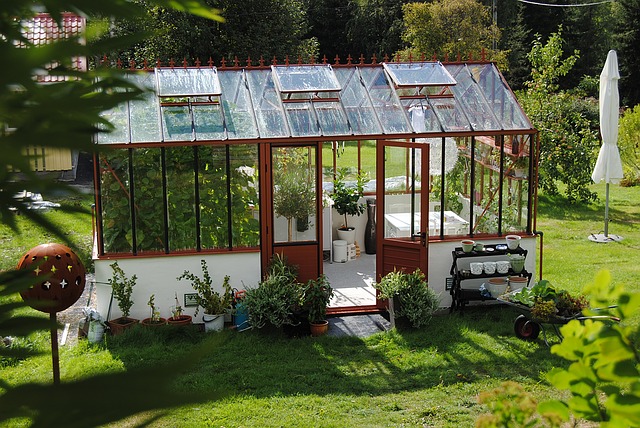BY DIANE WILCOX
Provident Living in a healthy environment starts with skilled people who share their talents: One of those talents is gardening. We believe it would be wise to have a small greenhouse and garden in everyone’s backyard if they are capable of doing so. We hope these examples will be helpful and inspiring enough to develop that talent in you.
Sanpete Valley’s greatest challenge for gardeners is its short growing season. Therefore, greenhouses, sunny south windows in the house with “grow lights,” “cold frames,” black plastic spread on the garden, then old warm blankets to cover “tender” plants in the fall have been used to extend the growing season long enough to ripen our fruits and vegetables for eating. Even Christmas lights wrapped around the lower limbs of fruit trees may keep blossoms alive to produce fruit when late spring frosts or early fall frost threatens.
Since we moved here in 1980, we have learned much from developing an above ground greenhouse to help friends get starts:
- Sowing seeds in the house: Plant in 3½” cups on tray without holes in the bottom and placed in sunny south windows in February, using grow lights as well.
- The temperature must be kept above 50 degrees and below 90 degrees for the seeds to sprout and develop.
- In our greenhouse temperatures are the same as in the home, but the trays have holes that help drain excess water which drips down onto the ground beneath to help water seeds that we have planted there: tomatoes, peppers, cucumbers, herbs, lettuce, spinach, and chard in that dirt with added soil, mulch, and natural fertilizer.
- Plants started in pots in the greenhouse in late March and early April include in this order: peppers, tomatoes, celery & onions; 1 week later: cabbage, kale, broccoli, cauliflower. 4-5 weeks later: cucumbers, melons, cantaloupe; 1 week later: herbs and flowers (This might vary).
- Plants that we directly seed into the garden after April 15 include root crops: potatoes & beets. We grow carrots & peas in grow boxes. After June 1st : corn, beans, chard, squash. Lettuce and like foods can be planted earlier.
- We’ve found that by the time these come up, the late spring frost (June 6-15) doesn’t hurt them.
- We transplant the “starts” that have been growing in the greenhouse out into our garden in the holes that have been cut in the 6 mil black plastic. The holes are cut & drilled with a 4” hole-saw then dirt is dug out with an auger 3” attachment. Both are attached to a drill. The hole is dug out about 4\” deep & 6” wide to set the “start” in. Excess soil is put back in if needed and everything is watered with sprinklers afterward. We watch the weather forecast for little windless, warm weather for when we are going to plant. This we do between June 8-15 unless weather reports change our mind. (Friends have helped us make this easy by putting up to 130 + transplants in the garden in 2-3 hours as well as 2 rows of onions, 1 row of cabbage, 1 of kale, 1 of broccoli, 1 of cauliflower, and 1 flat dutch cabbage starts planted in soil , not in plastic and in a shady area of the garden.)
- Here are some helpful hints for the greenhouse: Mix potting soil in a cement mixer using 1 part vermiculite with 3 or 4 parts “Black Gold” peat moss. Add either Azomite or Redmond mineral amendments for added minerals.
- We use “Turborganic” or liquid fertilizer (1 bucket chicken or cattle manure to 40 gal water – mixed and strained manure tea. Three weeks after planting, we start to use the fertilizer/manure tea several times a week. It is usually sprayed on the planet.
- For planting seeds in the cups, we usually place 2-3 seeds per cup. For celery and onions and herbs, we use a pinch of seeds in each cup while tomatoes, peppers, cruciferous plants are thinned to 1 plant per cup. Fertilizer adds nitrogen. Too much fertilizer “burns” the plants while too little starves or stunts their growth. Follow instructions on the liquid fertilizer. (Or experiment with “Manure tea” on weeds first before determining amount to spray on new plants.)
- Moderating Climate in the greenhouse: to keep temperature between 50 and 90 degrees, we use natural gas heaters and sometimes electric space heaters, close doors on both ends of the greenhouse, and double layer of clear plastic over the rebar or PVC framework. For cooling down temperatures, we use 2 or 3 electric box fans, “shade cloth” over the top, open doors on both ends, and roll up the plastic on both sides using PVC pipe to roll the plastic on.
- Watering: New seeds must be kept damp until they show they are sprouting so must be watered 2 or 3 times a day until about 3 or 4 inches tall and roots are developed. Then be careful not to over water or “damping-off” will happen–killing the stem and root. With too much water or too much hot fertilizer, the tips of leaves look dead or yellow.
- We rotate crops in the garden, changing where we place the black plastic which holds all the “warm weather plants”, so we usually take up the black plastic that we hold down with bricks and tires to use next year in another part of the garden.
- We usually till in: mulch, compost, leaves, and horse manure either in the fall and/or in the spring, before laying out the plastic again.
- Potatoes are planted using a garden tractor and trailer with a welded homemade “planter plow” in between them. One person drives slowly while the other person stands in the wagon full of buckets of potatoes and puts potato seed in a holder that drops them down a 4” pipe behind the plow planter. After which we use a disk behind the tractor to throw dirt over the potatoes, mounding them, as we drive between the rows. Most “weeding” of rows is done by tiller and hoes and is minimal.
- Resources:
- Steve Regan Co. (Spanish Fork, Richfield, Delta) Black Gold peat moss, 3 ½” square pots 100 to a case. Vermiculite 3 ½ cu.ft.bag; 3 1/2” square pot trays 50 to a case.
- Mountain Valley seed (now True Leaf Co) has hybrid and heritage seed; most are non-GMO and are organic grown.
- Two other sources of seed are: “Seeds of Change” and “Bakers Seed.”
- Horseshoe Hardware – 6 mil black plastic 20 x 100 $85
- Steve Regan Co “Tuflite” 6 mil greenhouse clear plastic. Lasts 5-7 years 20 x 100



